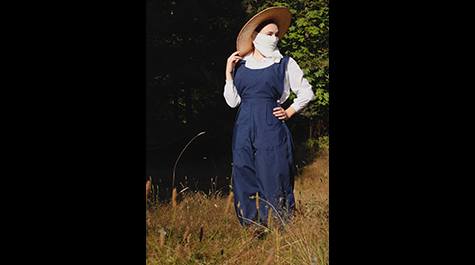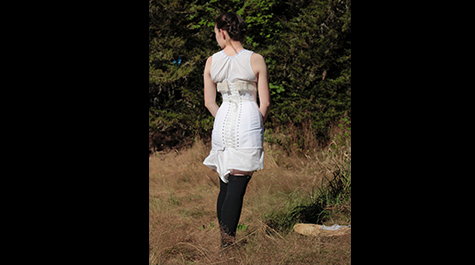Gracie Patten’s fashion research sews together history, status of early 20th century women
Many Americans celebrated the centennial anniversary of women’s suffrage in late August, which commemorated 100 years since the Nineteenth Amendment was ratified and women secured their right to vote nationwide. Thanks to a freshman Monroe Scholar summer research grant from the Charles Center, Gracie Patten ‘23 went beyond just celebrating the milestone this summer, delving into a little-known aspect of American womanhood in the waning months of World War One preceding suffrage’s passage.
As a history major, Patten was interested in pursuing research that integrated her discipline with her love for sewing and historical garments. After working extensively with costuming in high school, she sought a research opportunity that would incorporate those experiences while still broadening her academic horizons. These interests led her to apply for a first year Monroe Scholar grant, which funds students for three or more weeks of full-time mentored research during the summer following their freshman year.
In a unique blend of her extracurricular and academic passions, Patten ultimately decided to study fashion during WWI, specifically of the civilian Woman’s Land Army of America, an organization that mobilized young women — often dubbed farmerettes — to tend to agricultural lands left vacant by drafted men.
In order to analyze how farmerettes’ fashion affected their labor and social standing, Patten originally intended to visit the personal collection of military historian Alice Miller, who has amassed a trove of women’s uniforms from the 1900s. Unfortunately, COVID-19 restricted Patten's ability to safely travel to Miller’s WWI garment exhibition, preventing her from seeing the farmettes’ outfits in person.
This challenge caused Patten to adapt her research plans to encompass more online archival research, a change which Patten said enabled her greater flexibility than if she based her research on specific garments as she had initially planned.
“We decided that it probably wouldn’t be safe, so instead I did a lot of research looking at online collections,” Patten said. “... I decided to focus on the Woman’s Land Army, which didn’t really have an official uniform since it varied from state to state. I thought that would make it easier for me to branch out from the project because I wouldn’t have to follow something so specific and I wouldn’t have as much trouble sourcing materials.”
Patten utilized multiple virtual resources, including contemporary newspaper clippings and National Archive research, to gain a more comprehensive understanding of farmerettes’ fashion and to understand the historical contexts surrounding their work on farmlands across the country. She also read several books on the period to provide more insight into how women’s roles and fashion trends evolved throughout the time. She then sewed a sample Woman’s Land Army outfit from scratch, making realistic camisoles, understructures and overalls typical of a farmerette’s daily outfit.
Patten's faculty mentor for this Monroe Scholar project was Jay Watkins, Lecturer in the History Department. Professor Watkins noted that “When COVID necessitated rethinking of most everyone’s projects, Gracie was able to pivot brilliantly and take a deeper dive into the material culture and application aspects of the research. Though in the present we can’t ever experience the past, a project like Gracie’s construction of a garment gives us unique insight.”
One of the key discoveries that emerged during Patten's summer research became especially pertinent given ongoing national dialogues about racial inequality in the United States. In her research, Patten determined that farmerettes’ usage of a consistent uniform played an important role in differentiating them from Black agricultural laborers — thereby intensifying existing segregation between Black and white Americans.
“The uniforms, in addition to being important to have something to work in while you’re farming, ended up being a way of segregating the farmerettes from ‘ordinary’ farm laborers,” Patten said. “Having white women perform farm labor seemed so transgressive that I have concluded that having a uniform was really important to those organizing the farmettes, to negate that transgressiveness, and differentiate these mostly middle-class, white women from people who were usually farm laborers at that time, who were usually people of color and less well off.”
In addition to her sewing and research work, Patten also created three videos showcasing her garments and explaining their historical background for a general audience. While a socially-distanced friend helped her shoot these videos, Patten acquired enough video production skills and techniques in the final stages of her research grant that she was able to edit one of the videos entirely on her own.
{{youtube:large:center|cyB8tY9hqtA, Getting Dressed in 1918: Woman's Land Army of America Farmerette}}
Looking forward to her remaining three years at William & Mary, Patten intends to continue studying historical garments and cultural trends in fashion, especially utilizing the virtual research and video production skills she honed this summer. Whatever comes next, she will approach it with a strong set of research techniques under her belt. Although she was unable to visit a collection of actual uniforms, due to the pandemic, Patten sewed her own and therefore gained a very different connection to these historical uniforms than she would have from gazing at a display case.

















